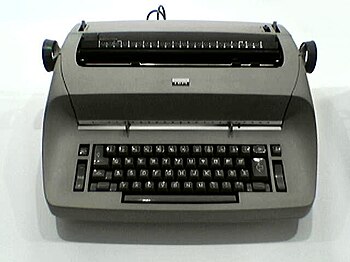
The “QWERTY” layout of typewriter keys became a de facto standard and continues to be used long after the reasons for its adoption (including reduction of key/lever entanglements) have ceased to apply. (Photo credit: Wikipedia)
What’s the best writing implement available? The short answer is the one that works for you. If you’re like me, however, you spend a lifetime trying different iterations until you settle on something more or less.
For some writers it is still the typewriter. Yes, some writers are yet hacking away on their old manual typewriters. Heck, I learned on one myself in 9th grade when I took typing for a year. That is where my heavy hands first took hold of a keyboard and let their fingers do the walking.
That heavy handed style of pounding the keys transitioned to IBM Selectric typewriters when I was first stationed at Subase New London, Groton, CT, where I worked on the base paper. It took some time to get used to the electric typewriter, though. But once I did, I felt I would only go back to a manual if I had to.
I was able to stay on electric typewriters until I was stationed on the USS Seattle (AOE-3). There I was that seagoing ammunition oiler’s sole journalist and responsible for the mimeograph newsletter that went out to the crew’s families and friends. Working on that newsletter was one painstaking labor of love as I know everyone looked forward to it, but the amount of man-hours it took me to throw it all together–including chasing down printers on the fly in exotic ports of call like Catania, Sicily, made it seem at times like an impossible task. But I always made it a no fail scenario and put editions to bed when they were needed.
Typing is probably the single most valuable skill I learned in school. It was something I was able to use in the real world over and over again. I could type fast and accurately and when I found out about the profession of typesetting, I was able to use my typing skills to make a living.
I loved writing stories the most but after I got out of the Navy, I stepped away from the keyboard for several years until I was able to land a typesetting job for a commercial printer in Boulder, CO. They gave me a typing test, I hit it out of the park and then they went about the task of teaching me all the coding necessary in order to make the phototypesetting machines output the ads and galley copy for paste-up artists that they were supposed to.
When I had an opportunity to work for ad agencies as a graphic artist on Macintosh computers I jumped at the chance. Here I could finally take my love for emerging technology, my ability to type quickly and accurately without looking down at the keyboard and make even more money than I was as a journeyman commercial printing typesetter.
This was doing me fine until I had a chance to catch on with RR Donnelley‘s Financial Business Unit as a document processor–aka typesetter. Financial printers are still the only places where you can find typesetters anymore. They simply went the way of hot type and phototypesetting machines.
At the test I took at the now defunct ad agency I wanted to work at near Denver International Airport, I was hired after typing over 100 words per minute. My hands and fingers were strong and rested from typing while working outdoors doing manual labor. Before I left typing on the job, I was diagnosed with carpal tunnel syndrome–mild in my left hand and moderate in my right. This was during a time when not much was known about this painful malady. I educated myself as best I could about the subject. Carpal Tunnel release surgery was in its infancy and everything I read pointed to the fact that even if the surgery was successful, if I returned to my keyboard-pounding ways and methodology, my painful symptoms could easily re-manifest themselves.
Not convinced the surgery could help me, I altered my technique and educated myself on the then phenomenon of ergonomics. I became the “ergonomics” guy at work. I was all about making sure operators had good chairs, used proper form and typing technique that would minimize wear, tear and stress on their hands, fingers, eyes, necks and bodies.
Typing is a sedentary act and you need to take frequent breaks. You also should consider an ergonomic keyboard. My all-time favorite is the Microsoft Natural Ergonomic Keyboard 4000 Rev. 1. I bought two of them back in the day. I’m still using the original and have the spare in the box whenever this one finally goes out on me (if it ever does).
Writers have favorite tools. I like my old Mac but I also am comfortable on an old PC I have that shares the same USB Microsoft keyboard. It all depends on what I am feeling. My recipe as a writer and blogger is to just write. The best laid plans of any writer are soon destroyed upon actually sitting down and watching what flows out of your fingers and onto the screen in front of you.
That was perhaps the main difference for me between typewriters and computers with word processing software. I was always more deliberate on manual and electric typewriters. I wanted to get it right from the start. Correcting errors was clunky compared to how spell check and the back space keys instantly identify and fix mistakes. Back in my Navy days, using white out and the white tape that you used to put between either the ball and the paper on an IBM Selectric or where the key struck the paper on a manual typewriter, was sort of an art. The key to any beautifully crafted masterpieces back then was not making too many mistakes in the first place. I prided myself in this as deadlines were inflexible and if you weren’t good you didn’t get it done during crunch time.
I’ve seen people frenetically texting on their smart phones. It just doesn’t look as cool as someone who can touch type confidently, like a concert pianist who can wink at someone in the wings with their hands never leaving the ivories. Sure there is dictation, but trust me, you’re not going to write anything of substance that way.
When it comes to creating, writing and drafting prose, there is still no substitute for the ability to create on the fly and as if possessed from your typing implement of choice–manual or electric typewriter or USB or Bluetooth keyboard on a computer with word processing software. And if you’re fortunate enough to be even half as lucky as I have been, you’ll be able to credit a good portion of the sheer joy you get as a writer to your ability to wield them effortlessly like lovers meant for one another.






